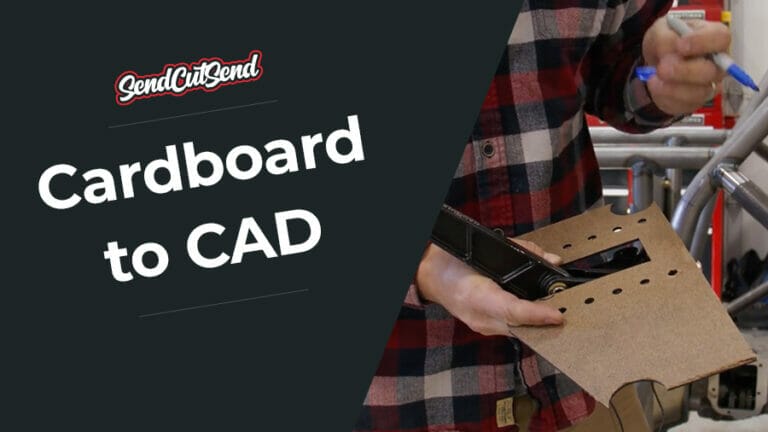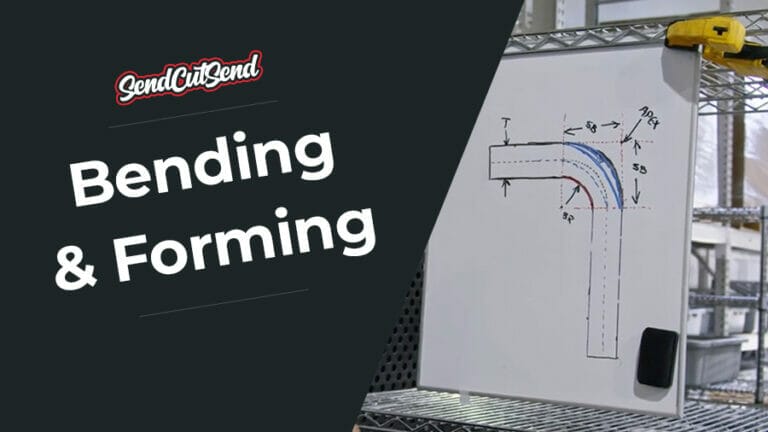Plastics are essential materials in modern manufacturing, offering strength, versatility, and cost-effectiveness across industries. Two of the most widely used clear plastics are polycarbonate and acrylic. At first glance they look nearly identical, but each has distinct properties that make it better suited for specific applications.
If you’re designing parts with SendCutSend, you’ll likely come across both of these materials. This guide compares polycarbonate vs. acrylic in terms of properties, durability, cost, and applications—so you can make an informed choice for your next project.
Read on.
Polycarbonate vs. Acrylic: Differences and Properties

Both polycarbonate and acrylic are thermoplastic polymers. That means they soften when heated and harden again when cooled, making them moldable and recyclable. Unlike thermosetting plastics, which cannot be reshaped once formed, thermoplastics offer flexibility in processing.
- Trade names: Polycarbonate is often known by its brand name Lexan, while acrylic is commonly called Plexiglass (or Plexiglas).
- Appearance: Both materials are naturally clear but can be tinted in different colors.
- Formability: Either material can be extruded into various shapes. Polycarbonate is often injection molded to make containers like bottles and other shapes. Acrylic can be extruded or cast, but extruding can leave the material with direction specific properties, where it’s stronger in one direction and weaker than another. Casting acrylic produces much more uniform properties. SendCutSend uses cast acrylic.
- Glass alternatives: They’re lighter, more impact resistant, and safer to handle than glass, though they can scratch more easily.
- Chemical resistance: Under the right conditions, they each have good chemical resistance. Weak acids, detergents and most solvents are fine. Acetone won’t necessarily dissolve either, but it can cause softening and damage. Isopropyl alcohol is a better alternative for polycarbonate, but don’t use it on acrylic.
Key Differences Between Acrylic & Polycarbonate

While they share many traits, the differences between acrylic and polycarbonate determine their best use cases.
- Scratch Resistance: Acrylic is harder, giving it better scratch resistance.
- Impact Strength: Polycarbonate is tougher and can withstand impacts up to 250x stronger than glass.
- Optical Clarity: Acrylic takes the win, offering superior transparency—even clearer than glass.
- Flexibility: Polycarbonate can handle plastic deformation, meaning it can be bent into permanent shapes similar to sheet metal. In fact, bending polycarbonate is a service SendCutSend offers. Acrylic on the other hand is more brittle, but still much more flexible than glass. Acrylic can be bent, but requires being heated to prevent cracking.
- Temperature Resistance: Polycarbonate maintains toughness at very low temperatures, while acrylic performs better under long-term UV exposure.
- Flame Resistance: Polycarbonate resists flames better; acrylic edges can be flame polished for a smooth finish.
- Bonding: Acrylic bonds more cleanly with adhesives, often leaving invisible joints.
- Cost: Acrylic is generally less expensive, often around half the cost of polycarbonate for similar thicknesses.
If specs are your thing, we’ve got those too. You can see from some of these values just how similar these materials are, and how they differ.
| Acrylic Properties | Polycarbonate Properties | |||
| Density | 74 lb/ft^3 | Density | 75 lb/ft^3 | |
| Tensile Strength (Ultimate) | 10 ksi | Tensile Strength (Ultimate) | 9.5 ksi | |
| Shear Modulus | 250 ksi | Shear Modulus | 120 ksi | |
| Flexural Strength | 16 ksi | Flexural Strength | 13 ksi | |
| Rockwell Hardness | M93 | Rockwell Hardness | 68 | |
| Elongation at Break | 0.04 | Elongation at Break | 1.1 | |
| Elastic Modulus | 460 ksi | Elastic Modulus | 340 ksi | |
| Comprehensive (Crushing) Strength | 16 ksi | Comprehensive (Crushing) Strength | 12 ksi | |
| Thermal Conductivity | 0.11 BTU/h-ft-°F | Thermal Conductivity | 0.11 BTU/h-ft-°F | |
| Melting Point | 360 °F | Maximum Temp (Decomposition) | 890 °F | |
| Magnetic | No | Magnetic | No | |
| Acrylic Services | Polycarbonate Service | |||
| Cutting Process | CO2 Laser | Cutting Process | CNC Router | |
| Bending | No | Bending | Yes | |
| Tapping | No | Tapping | Yes | |
You can check out even more information for acrylic and polycarbonate on their respective material pages.
Acrylic and Polycarbonate Plastic Uses
As we mentioned, acrylic and polycarbonate are very similar with subtle differences. Both are regularly used as lightweight replacements for glass or in applications where impacts could break regular glass. Let’s explore some common applications for each.
Common Polycarbonate Applications
Because polycarbonate is known for incredible impact resistance it tends to be used more in applications where safety or performance are needed.
- Bullet-resistant and safety windows
- Motorsports and aircraft windshields
- Face shields, goggles, and protective guards
- Greenhouse and roofing panels
- Electronics housings and lenses
- CDs, DVDs, and Blu-ray discs
Common Acrylic Applications
The lower cost and better clarity of acrylic make it the more common choice for less critical applications and decorative applications.
- Retail and trade show signage
- Lighting diffusers and decorative panels
- Aquariums and displays
- Desk and tabletop covers
- Custom ornaments and creative projects
- General glass replacement where impacts are minimal
There’s no limit to what can be made with either of these amazing materials. If you’re looking for some inspiration, check out what our customers have made using acrylic and polycarbonate.
Polycarbonate vs. Acrylic: How Much Do They Cost?
Price often plays a key role in material selection. On average:
- Acrylic is the lower-cost option, often around half the cost of polycarbonate in clear sheets.
- Polycarbonate is more expensive, but the cost is justified in applications where toughness and impact resistance are critical.
At SendCutSend, you can upload your design and receive instant pricing for both materials, with cost differences clearly shown before you order.

Polycarbonate vs. Acrylic: Recyclability & Sustainability
Both acrylic and polycarbonate are recyclable (group 7 plastics). While not all facilities process group 7, they can be repurposed into new products. Because they’re thermoplastics, they can be reheated and reshaped, reducing waste at the end of their lifecycle. Recycled versions of both materials are also available in the supply chain.
How to Choose Between Polycarbonate & Acrylic
To summarize:
- Choose polycarbonate when you need toughness, impact resistance, cold-weather durability, or parts that require bending.
- Choose acrylic when you want maximum clarity, UV resistance, or a cost-effective option for decorative or lightweight structural applications.
SendCutSend makes it easy to order both materials, cut to your exact design. With laser-cut acrylic in multiple colors and bendable CNC-machined polycarbonate, you’ll get parts shipped fast, ready to use right out of the box.
If you’re not sure which material to pick, check out our material selection guide or contact our applications team. Upload your design today and get instant pricing for custom acrylic and polycarbonate parts.




